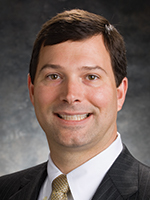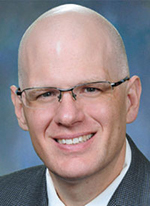
Dr. Longshore
He agrees there seems to have been a slow uptake of liquid biopsy, but notes that given the direct-to-oncologist marketing of panel-based tests like GeneStrat or Guardant360, he isn’t getting the whole picture. “I’m sure my oncologists are ordering more plasma testing. It doesn’t come to pathology, so I’m not aware of those orders.” In such cases, he adds, it can be challenging for hospital-based pathologists to be part of a multidisciplinary patient management approach.
Initial concerns that the plasma test was relatively insensitive compared with tissue have faded. “When we have taken samples and performed next-generation sequencing in parallel with the Cobas EGFR plasma test, the results correlate about 92 percent of the time. That tells me it’s not really an issue with the technology that is used, but more the fact that only two-thirds of patients shed circulating DNA into their peripheral circulation.”
Preanalytical issues can arise, Dr. Longshore notes. “Obviously the circulating DNA fragments are very small and quite labile, so we want to try to separate the plasma from the remaining blood components within four hours after collection to prevent degradation of the ctDNA. The ability to have a tube to preserve ctDNA and not have to perform separation immediately certainly would be of benefit,” he says. A workaround might be to use preservative tubes such as Ariosa tubes, although those would be off-label uses. At some remote settings, the plasma may have to be separated from the remaining blood components before refrigeration or frozen shipment to a biomarker lab, which can be a cumbersome process in a medical office or small hospital.
Clinicians may need further education on the caveats needed to understand positive and negative plasma test results, Dr. Longshore says, and he hopes the clinical guideline that the CAP, AMP, and IASLC are finalizing, on the selection of lung cancer patients for treatment with TKI, will help clinicians and pathologists deal with the diagnostic dilemmas, how to triage patients with a negative result, how to back up results with a second biopsy, and so on.
“When you understand the good and bad side of both tissue- and plasma-based techniques, and how they complement each other, if you can find a way to use them in the appropriate settings and in the correct order, together they can be quite powerful,” he says.
Clinicians may also need guidance on appropriate ordering. Now that the clinical implementation of a laboratory-developed EGFR ctDNA test has been running for more than a year at Brigham and Women’s Hospital, “we’ve found that clinicians will often order this test when a patient comes in with a perceived lung mass and doesn’t necessarily have a definitive diagnosis of carcinoma or lung adenocarcinoma,” says Lynette M. Sholl, MD, associate pathologist and associate director of the Center for Advanced Molecular Diagnostics at Brigham and Women’s in Boston and assistant professor at Harvard Medical School. These patients often have a diagnosis other than lung cancer once the biopsy is obtained. The assay is simply not informative in this and other situations.
When the new CAP/IASLC/AMP guideline for molecular biomarkers is released, it will reflect what the FDA approval has been around this type of technology, Dr. Sholl says. “That is, if you’re looking at individual gene targets—in our case EGFR mutations—it’s appropriate for patients who have an established diagnosis of lung adenocarcinoma and are receiving targeted therapy with suspected relapse, and for those patients with a new diagnosis whose tissue is either insufficient or inaccessible for molecular testing.”
One recent case at Brigham and Women’s involved a patient with a morphologically undifferentiated malignancy in which access to commercial liquid biopsy results helped clarify the diagnosis. “Identification of an ALK rearrangement in the plasma ctDNA—the results of which arrived as we were working the case up with immunohistochemistry—helped get us to a diagnosis of dedifferentiated lung carcinoma.”
In many institutions, pathologists may be unaware of how often liquid biopsies are sent out, Dr. Sholl points out. At Brigham and Women’s, “the oncologists are very much linked in with us, and when they get an unexpected or particularly informative result back from a commercial lab, they have let us know. But you can imagine scenarios in which that doesn’t happen. If you look at the numbers advertised by commercial labs, they appear to be testing tons of cases. It’s just not getting fully integrated into the diagnostic workup of the individual patient on the pathology side.”
Some institutions are diving in. “We use liquid biopsy on every patient who has a bronchoscopy,” says Mark R. Bowling, MD, associate professor of medicine, Paul R. and Katherine M. Hettinger Walker distinguished professor of clinical oncology, and director of interventional pulmonology and pulmonary diagnostic services at East Carolina University School of Medicine and Vidant Health System. All such patients have blood drawn and tested using the Biodesix GeneStrat.

Dr. Bowling
“We know from the data that patients do better when they get on appropriate therapy earlier, and we are putting together an algorithm of therapies that we follow based on the liquid biopsy results we get in 72 hours. For example, if there’s an EGFR or an ALK mutation, we can bring in a TKI much earlier. Since the KRAS mutation doesn’t respond very well to radiation or basic chemotherapy, we can use the blood-based testing to identify three subtypes of the KRAS mutation, which may lead to additional treatment options.”
Dr. Bowling’s team is analyzing data on recent use of liquid biopsy, including the one-year outcomes of those patients, and hopes to have results to publish soon. “In a 10-month period, we tested 194 patients with Biodesix, and we had a change of therapy in one out of every three of those patients based on the test. We’re comparing the outcomes of the patients before we had the Biodesix versus the ones we’re getting now to see if there’s any difference in the amount of time to appropriate therapy and ultimately survival outcomes between the two groups.”
He, too, has witnessed limited use of liquid biopsy by doctors in private practice whom he meets in his travels—although pulmonologists, who see the limitations and difficulties of invasive tissue biopsies, have embraced liquid biopsy a little more than oncologists. “You’re starting to see more use, but some people, including academics, don’t want to hear anything about it, they don’t trust it, they don’t believe in it. They want tissue, and I get that. But what we have to do in the medical community is get the data together in a scientifically sound way, and put it out for peer review so people can decide for themselves.”
Only one person can diagnose lung cancer, and that’s the pathologist, with biopsies, Dr. Bowling emphasizes. “Obviously the pathologist has to be at the forefront of this development of technology. I don’t think we’ll ever in the foreseeable future replace tissue. But liquid biopsy is certainly an adjunct—and it certainly helps.”
[hr]
Anne Paxton is a writer and attorney in Seattle.
 CAP TODAY Pathology/Laboratory Medicine/Laboratory Management
CAP TODAY Pathology/Laboratory Medicine/Laboratory Management
